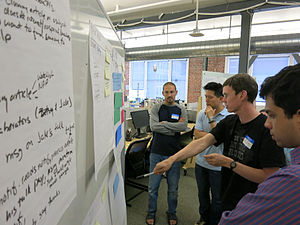When an article on Wikipedia is available in multiple languages, we see the list of those languages in a column on the side of the page. The language names in the list are written in the script that the language uses (also known as language autonym).
This also means that all the appropriate fonts are needed for the autonyms to be correctly displayed. For instance, an article like the one about the Nobel Prize is available in more than 125 languages and requires approximately 35 different fonts to display the names of all the languages in the sidebar.

Language Autonyms
Initially, this was handled by the native fonts available on the reader’s device. If a font was not present, the user would see square boxes (commonly referred to as tofu) instead of the name of a language. To work around this problem, not just for the language list, but for other sections in the content area as well, the Universal Language Selector (ULS) started to provide a set of webfonts that were loaded with the page.
While this ensured that more language names would be correctly displayed, the presence of so many fonts dramatically increased the weight of the pages, which therefore loaded much more slowly for users than before. To improve client-side performance, webfonts were set not to be used for the Interlanguage links in the sidebar anymore.
Removing webfonts from the Interlanguage links was the easy and immediate solution, but it also took us back to the sup-optimal multilingual experience that we were trying to solve in the first place. Articles may be perfectly displayed thanks to web fonts, but if a link is not displayed in the language list, many users will not be able to discover that there is a version of the article in their language.
Autonyms were not needed just for Interlanguage links. They were also required for the Language Search and Selection window of the Universal Language Selector, which allows users to find their language if they are on a wiki displaying content in a script unfamiliar to them.

Missing font or “tofu”
As a solution, the Language Engineers came up with a trimmed-down font that only contains the characters required to display the names of the languages supported in MediaWiki. It has been named the Autonym font and will be used when only the autonyms are to be displayed on the page. At just over 50KB in size, it currently provides support for nearly 95% of the 400+ supported languages. The pending issues list identifies the problems with rendering and missing glyphs for some languages. If your language misses glyphs and you know of an openly-licensed font that can fill that void, please let us know so we can add it.
The autonym font addresses a very specific use case. There have been requests to explore the possibility of extending the use of this font to similar language lists, like the ones found on Wikimedia Commons. Within MediaWiki, the font can be used easily through a CSS class named autonym.
The Autonym font has been released for free use with the SIL Open Font License, Version 1.1.
Runa Bhattacharjee, Outreach and QA coordinator, Language Engineering, Wikimedia Foundation






